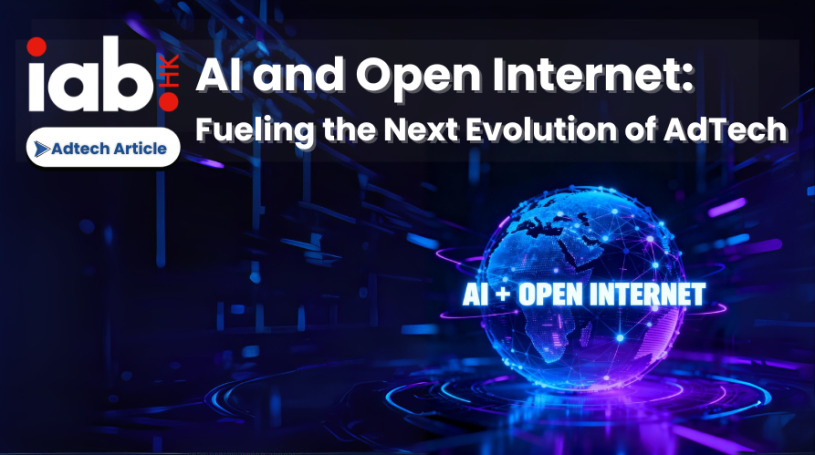AI and Open Internet: Fueling the Next Evolution of AdTech
Introduction
The Open Internet serves as a vast foundation and ecosystem, fueling the continuous innovation and expansion of artificial intelligence (AI). By providing accessible, diverse, and ever-growing public data, the Open Internet has enabled AI systems to learn, adapt, and deliver increasingly sophisticated solutions. This synergy is particularly apparent in advertising technology (AdTech), where the Open Internet not only broadens audience reach but also equips AI with rich data signals. In this article, we explore how AI and the Open Internet are transforming AdTech both vertically across market funnels and horizontally across technical functions.
The Vertical – Across Marketing Funnels
Awareness (Top of Funnel): Driving Quality Reach and Brand Impact
At the top of the funnel, advertisers focus on boosting brand exposure with potential customers in high-attention advertising environments. By harnessing the advantages of AI and Open Internet, advertisers can accurately pinpoint the best inventory to drive quality reach and brand impact while keeping fraud protection and brand safety at the forefront.
- Identify and Evaluate the Optimal Inventory: Some AdTech platforms leverage AI-driven predictive analytics and big data from the Open Internet to identify and evaluate the optimal advertising inventory across channels. For example, The Trade Desk uses AI-powered quality metrics to measure and optimize inventory selection: TV Quality Index assesses Connected TV and online video inventory based on content quality and ad experience to increase brand impact, while Quality Reach Index measures the audience reach based on similarities to a brand’s most valuable customers to enhance relevance.
- Fraud Detection and Brand Safety: Protecting advertising investments is paramount. AI-powered systems continuously monitor for fraudulent activity and ensure brand safety by preventing ads from appearing alongside inappropriate content. This maintains the integrity of campaigns and ensures that ad spend is directed towards legitimate engagement.
Consideration (Middle of Funnel): Nurturing Interest and Strengthening Engagement
On the Open Internet, where discovery is paramount, AI-powered solutions are essential for connecting advertisers with highly engaged audiences at the right moment, fostering intent, and ultimately leading to measurable results. At the consideration stage, the purpose is to deepen engagement and provide consumers with the information they need to move closer to a purchase decision. AI plays a critical role here by:
- Audience Segmentation: AdTech platforms utilize AI to analyze vast amounts of behavioral data across thousands of publishers on the Open Internet to predict which users are most likely to engage with specific content or products. This allows for hyper-targeted content recommendations and native ad placements that resonate with individual user interests, nurturing curiosity and driving clicks.
- Contextual Intelligence: Beyond user behavior, AI understands the context of the content being consumed. This means placing relevant ads and recommendations within articles, videos, and other editorial environments where users are already actively engaged and open to discovering new information. This seamless integration enhances the user experience and increases the likelihood of consideration.
- Personalized Content Recommendations: AI-driven recommendation engines guide users to additional relevant content, products, or services after their initial engagement. This extends the consideration phase, keeps the brand top-of-mind, and provides ample opportunities for users to delve deeper into what a brand has to offer.
Conversion (Bottom of Funnel): Maximizing ROI with Intelligent Optimization
The end goal of advertising is to generate conversions, and AI is the key to unlocking superior performance in the bottom of the funnel. Several pioneering AdTech platforms, such as Appier, Quantcast, and Taboola excel in a variety of areas:
- Intelligent Bidding and Budget Optimization: AI algorithms analyze real-time performance data to automatically adjust bids and allocate budgets to campaigns, ad groups, and placements that are most likely to drive conversions. This ensures that every advertising dollar is working as hard as possible, maximizing return on ad spend (ROAS).
- Predictive Modeling and Prospecting: Building on existing customer data, AI identifies new audiences on the Open Internet who share similar characteristics and behaviors to a brand's most valuable customers. This allows for efficient prospecting of high-intent users, expanding reach while maintaining a strong focus on conversion potential.
- Attribution Modeling: AI provides more sophisticated attribution models, allowing advertisers to understand the true impact of different touchpoints across the Open Internet on conversions. This moves beyond last-click attribution, providing a more holistic view of performance and enabling smarter future investments.
The Horizontal – Across Technical Functions
Audience Prioritization
AI helps advertisers to prioritize the most relevant audiences. For instance, The Trade Desk applies AI to an advertiser’s own converted customer data or proxies as Seed audiences. The Seed audience acts as a north star for campaign decisions, accelerating machine learning and guiding campaigns to deliver more relevant advertisements effectively to right audiences. This ensures that ad spend is focused on reaching users who closely resemble past purchasers or converters.
Creative Production
AI streamlines creative production by automating tasks like generating variations of ad copy, headlines, and visuals. It analyzes past campaign performance and audience preferences to suggest optimal creative elements, ensuring higher engagement rates. Furthermore, AI-powered tools can facilitate Dynamic Creative Optimization (DCO), allowing advertisers to test and adapt
creatives in real-time based on user responses and contextual cues, ultimately leading to more effective and personalized ad experiences on the Open Internet.
Performance Optimization
With advanced machine learning algorithms, AI continuously analyzes campaign data in real-time, identifying patterns and optimizing various parameters and matching the right audience at right moment in right placement across the Open Internet to maximize performance. This includes intelligent bidding strategies that dynamically adjust bids based on predicted impression value, ensuring optimal budget allocation.
Balancing with Humanity
Human Touch and Authenticity
While AI delivers unmatched efficiency and precision, human touch and authenticity are irreplaceable. The best advertising campaigns arise from a harmonious collaboration where AI handles data-intensive tasks and optimization, while humans craft narratives, brand voice, and culturally sensitive messaging by infusing advertising campaigns with emotion, empathy, and genuine purpose.
Human Choice and Control
Transparency and accountability in AI decision-making are essential. Advertisers should maintain granular control over data usage, inventory quality, audience prioritization, and budget allocation. This enables full visibility and manual adjustments to AI-driven decisions while supporting advertiser objectives and upholding regulatory compliance.
Conclusion
The evolution of AdTech is driven by the dynamic interplay between AI and the Open Internet. The Open Internet provides a critical foundation and diverse ecosystem where innovation thrives and data flows freely. The accessible data on Open Internet empowers AI to continually learn, adapt, and refine advertising strategies across marketing funnels and technical functions, making advertising campaigns more personalized and more impactful.
When harmonized with humanity, AI and the Open Internet together will continue to propel AdTech forward, shaping an industry that is inclusive, effective, and ever more innovative.
Author: | |
Mary Tse |  |
| |
Jo Chow |  |
| Article launched on 2/10/2025 |
APPENDIX
About the IAB (Hong Kong)
The Interactive Advertising Bureau (Hong Kong) empowers the media and marketing industries in Hong Kong, to thrive in the digital economy. It is comprised of more than 100 leading media and technology companies that are responsible for selling, delivering, and optimizing digital campaigns. Working with its member companies, the IAB (Hong Kong) evaluates and recommends standards and practices and fields critical research on interactive advertising.
Please address any questions or comments about this blog to
IAB (Hong Kong) Secretariat Office- info@iabhongkong.com


